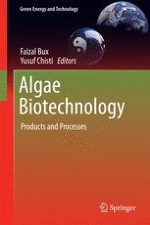2016 | OriginalPaper | Buchkapitel
Microalgae Applications in Wastewater Treatment
verfasst von : Ismail Rawat, Sanjay K. Gupta, Amritanshu Shriwastav, Poonam Singh, Sheena Kumari, Faizal Bux
Erschienen in: Algae Biotechnology
Aktivieren Sie unsere intelligente Suche, um passende Fachinhalte oder Patente zu finden.
Wählen Sie Textabschnitte aus um mit Künstlicher Intelligenz passenden Patente zu finden. powered by
Markieren Sie Textabschnitte, um KI-gestützt weitere passende Inhalte zu finden. powered by
Abstract
Algal wastewater treatment is effective in the removal of nutrients (C, N and P), coliform bacteria, heavy metals and the reduction of chemical and biological oxygen demand, removal and/or degradation of xenobiotic compounds and other contaminants. Microalgae wastewater treatment technologies have long been in existence; however, uptake of the technology to date has been limited mainly due to considerations of land requirements and volumes of wastewater to be treated. This chapter gives an overview of algal applications in wastewater treatment with specific reference to nutrient removal, phycoremediation of heavy metals, high-rate algal ponds, symbiosis of algae with bacteria for wastewater treatment, and utilisation of wastewater-grown microalgae.
